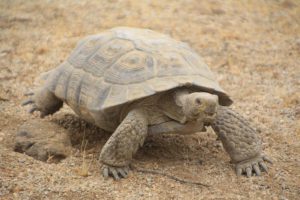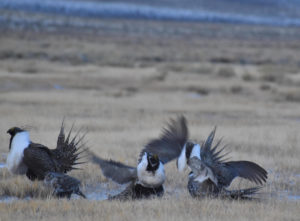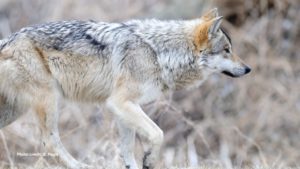For Release: Monday, July 18, 2022
Contacts:
Lindsay Larris, WildEarth Guardians, 720-334-7636, llarris@wildearthguardians.org
Dillon Hanson-Ahumada, Endangered Species Coalition, 402-507-8222, dhanson@endangered.org
Andrea Zaccardi, Center for Biological Diversity, 303-854-7748, azaccardi@biologicaldiversity.org
Michelle Lute, Project Coyote, 406-848-4910, mlute@projectcoyote.org
Erik Molvar, Western Watersheds Project, 307-399-7910, emolvar@westernwatersheds.org
Proposal is an alternative to CPW-led efforts focused on limiting and “managing” wolves
Denver, CO—Today, a group of 14 conservation and wildlife organizations, led by WildEarth Guardians, put forward their “Colorado Wolf Restoration Plan” as a science-based proposal to guide wolf reintroduction and recovery in Colorado following the passage of Proposition 114 in 2020. The plan focuses on bringing about the immensely positive ecological, economic, and social opportunities for Coloradans and the Colorado landscapes that have been missing wolves for so long by ensuring a self-sustaining, robust population of wolves throughout the Western Slope.
“Colorado needs a plan that focuses on wolf restoration, not wolf ‘management”,” said Lindsay Larris, wildlife program director of WildEarth Guardians. “WildEarth Guardians saw the need to develop a plan that prioritizes restoring a self-sustaining population of wolves to Colorado, and recognizes that human and wildlife interests can coexist. Colorado has an incredible opportunity to change the narrative for treatment of wolves across the West, and we wanted to show what was possible through this plan.”
“Supporting a plan that considers the Wolf as a symbiotic spirit to the needs of ecology is essential for balance of soil systems in prairie lands and mountains,” said Nancy Rae Kochis-Clark founder of Herbal Gardens Wellness. “We at Herbal Gardens Wellness believe in the balance of our health as related to the integrative living of traditional models of health and environmental stewardship.”
“The restoration of this iconic animal to the wild places of Colorado is a remarkable conservation achievement, and something in which Coloradans can really take pride,” said Dillon Hanson-Ahumada, Denver-based, Southern Rockies Representative for the Endangered Species Coalition. “The principles in this plan will allow wolves to roam and coexist in the many areas of suitable habitat in Colorado.”
Proposition 114 requires the establishment and maintenance of a “self-sustaining” population of gray wolves in part to “help restore a critical balance in nature.” The plan includes four main elements that are key to any wolf restoration effort: reintroduction areas, a population goal, management guidelines, and compensation considerations.
Based on large suitable habitat blocks, connectivity, and prey presence, the plan identifies twelve optimal areas for initial wolf reintroductions. The areas are dispersed throughout the Western Slope and would ensure the benefits of wolves are distributed across Colorado, as was the intent of Proposition 114.
“Colorado deserves a wolf management plan that maximizes the successful recovery of wolves, helps them take their rightful place as a critical part of mountain ecosystems,” said Erik Molvar, Executive Director of Western Watersheds Project. “Science must form the foundation of wolf restoration in Colorado, so that future decisions are guided by a sound framework of scientific knowledge, rather than the whims of political caprice.”
At the heart of the plan is a robust population goal for Colorado wolves. The best available science on self-sustaining populations and modeling of the Western Slope’s carrying capacity for wolves both indicate a minimum population of 150 packs or approximately 750 wolves. The plan is clear that 750 wolves is not a cap, but a minimum requirement for future state delisting from “threatened” to “nongame” status.
Livestock loss prevention and compensation is also a major feature of the plan. Non-lethal deterrents and conflict minimization tactics are encouraged, and in some cases required, for state assistance. The plan clearly sets out parameters that encourage coexistence and account for the inevitability of some conflict and livestock loss.
“This plan is critical to ensuring Colorado recovers wolves the right way, the first time,” explains Michelle Lute, PhD in wolf conservation and carnivore conservation director for Project Coyote. “All other wolf recovery efforts are mired in controversy because ineffective and counterproductive lethal methods are allowed. Non-lethal tools allow wolf populations at ecologically-effective densities and coexistence with humans and domestic animals.”
“Wolves have a tremendous impact on biodiversity and ecosystem health. By reducing overbrowsing by elk and deer, wolves improve the quality of riparian habitat, which benefits beavers, songbirds, amphibians, and fish,” said Johanna Hamburger, director and senior staff attorney for AWI’s terrestrial wildlife program. “The plan lays out a path forward that would restore balance to landscapes across the Western Slope.”
“Coloradans need to know that killing wolves is not the best way forward,” said Andrea Zaccardi, legal director of the carnivore conservation program at the Center for Biological Diversity. “Our alternative wolf-restoration plan proposes common-sense rules to prevent conflict between livestock and wolves. It gives livestock owners incentives to take responsibility for their deceased livestock, which can attract wolves to vulnerable cattle and sheep. It also prohibits the killing of wolves for preying on livestock on the public lands we all share.”
Delia G. Malone, Wildlife Chair for Colorado Sierra Club: “Colorado needs wolves. Wolves evolved with our native wildlife and accordingly, these species and the habitats upon which they depend, need these keystone, apex carnivores to keep their populations healthy. But wolves can only fulfill their ecological role if their family groups are intact and not disrupted by human persecution. Where wolves are protected from recreational killing and lethal control, their benefits reach to enhancing biodiversity, improving climate resilience, and even enriching our own lives.
Wolves are a part of our natural heritage, a legacy for now and future generations of Coloradans, but only if we decide to change our relationship with the land and its native species from one of domination to one of stewardship. Our vision of Colorado as a sustainable model of gray wolf stewardship can be realized with this restoration plan”.
The plan will be given to Colorado Parks and Wildlife Commissioners prior to their July 21st meeting in Edwards, Colorado. The endorsing organizations hope that the plan will be evaluated as a viable way to fulfill the intent and text of Proposition 114.
# # #
WildEarth Guardians, Colorado Sierra Club, and the Humane Society of the United States are hosting a webinar to discuss the plan on Tuesday, July 19th at 12pm MDT. Details and registration here: https://guardiansaction.org/COWolfWebinar





